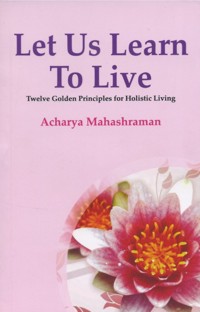One whose consciousness is sleeping is deluded even while physically awake.
Conversely, a spiritual person is consciously awake even in sleep.Alternating activity and rest is natural. It's symbolized by night and day and the sun and moon. The physical body is impacted by the sympathetic and parasympathetic systems. Balancing sleep and wakefulness is crucial to imparting balance to life.
After being active through the day, one needs to "recharge" by sleeping. Sleep not only keeps the body fit and functional but is also conducive to mental relaxation.
The amount of sleep required varies from person to person. Some feel rested and refreshed even after a brief nap, whereas others, despite sleeping for hours and hours, may remain tired, sluggish and aching. Yogis and saints reduce their sleep requirements by training their body and mind. Bhagavan Mahavira slept very little during his twelve-and-a-half long years of penance.
Generally speaking, the duration of sleep is determined by body's conditioning. Newborns and infants tend to sleep, sweet and sound, most of the day and night. As they grow, the need for sleep gradually decreases. Adults manage well with just a few hours of snoozing.
Art of Deep Sleep
Everyone longs for regular sound, deep, and restful sleep. Acharya Shree Mahapragya, who recently passed away in at the age of ninety, who led a group of nearly eight hundred monks and nuns and had millions of followers, drifted off as soon as he lay down. This kind of sleep is truly artistic. Everybody sleeps, but only a few know the art of sleeping.
People also desire the right amount of sleep. Neither excessive sleeping nor staying awake too long is healthy. Experts believe that sleep deprivation in the early years has a negative impact on mental and physical health later in life.
While eating, drinking, sitting, standing or walking, a person's mind is cluttered by all kinds of thoughts. And even sleep does not leave one alone since the thinking process may keep going on and on! The following anecdote illustrates this point:A cloth merchant was so besieged with his business while sleeping that he dreamed he was selling clothes to a customer. He measured and began tearing pieces of cloth. When he awoke, he found that he had torn the very clothes he was wearing!
People perform different activities in their dreams because they are unable to sleep restfully. They sleep with all sorts of information stored in the mind, fueling continuous subconscious churning of the thought process. For a sweet and deep sleep, one must expunge these thoughts and their emotional impact before going to bed. A relaxed state of psyche facilitates soothing sleep.
In these times man has lost many of his valuable natural assets, including the ability to sleep, with deleterious and sometimes even disastrous consequences. Insomniacs resort to all sorts of remedies, even prescription medications, which may eventually take a heavy toll. An easier and more practical solution for sleeplessness is Preksha, a technique of yoga and meditation. Kayotsarg, a Preksha exercise that relaxes the mind and body is a prerequisite for refreshing sleep. Deep breathing also calms the flickering mind. And both these "therapies" are completely safe and totally free!
Sleeping Consciousness
Both the quality as well as the quantity of sleep is governed by the nature of a person. When looked at from the perspective of karma sleep is related to Darshanavaraniya Karma (Perception covering karma). Sleeping consciousness - sleeping even when awake - has been attributed to bad karma and is deemed unhealthy. It hampers self-development, results in Avirati (lack of restraint) and Adharmacharan (sinful indulgence), all of which ultimately lead to misery. Insomnia has been ascribed to Asatavedaniya Karma (pain rendering karma).
The Acharanga Agama (Scripture) states: "Sutta amuni saya, munino saya jagaranti" meaning "the spiritual person is always awake while the naive remain asleep". It points to the vigilance of a spiritual practitioner and the ignorance of the ordinary. The Gita says: "Ya nisha sarvabhutanam tasyam jagarti samyami." This means "night is the time for common people to drift off to sleep, but monks stay vigilant even while snoozing."
In conveying the same message Gurudev Tulsi included the ignorant also in it. In his composition Ahrat Vani he says:
"Amuni-agyani sada sote rahe hain,
Jagkar bhi ve aho din rat sote.
Muni-gyam jagte rahate nirantar,
Dravya nidra ken bhi ve sajag bote.""The attached and the unaware actually lie in slumber day and night, even when they are awake. However, the monks and the learned remain attentive while asleep."
If a person cannot free himself from attachments and does not practice restraint even after becoming a monk he is not truly awake -despite being physically awake.
Once there lived an ascetic who was initiated at a young age. Although he had renounced the world, he was still mentally attached to it. He had not overcome his lust and his inner being remained dormant. He felt that any talk of atma-paramatma (soul and Supreme Soul) was false. If there was a God, he should have seen him by now. Further, he felt he was misled when persuaded to leave the pleasures of the world in pursuit of the spiritual life. Thinking thus he decided to return home.
On his way home he spotted a childhood friend at work in shop. As they conversed, the ascetic asked him what was stored in the containers on display. His friend opened a few of them to show him what they contained - butter, sugar, salt, chilies, ginger, etc. However, there were two containers in a corner that aroused the ascetic's curiosity. The friend told him they contained just 'Ram-Ram'. The ascetic was baffled by this answer. The friend explained with a smile, "Mahatmaji! You won't understand the language of our society. When any item is completely sold out, we don't always tell the customer the container is empty. Instead we say it is now 'Ram-Ram' and they immediately understand!"
This simple event diverted and impressed the ascetic. He realized that one had to be "empty" (free from negativities) to achieve 'Ram-Ram'. And to reach this goal he had to clear his mind too. As long as the mind is filled with anger, jealousy, hatred, pride and doubts it continuously breeds common human desires, leaving no room for Ram (the hero of the Ramayana), the power of discrimination, and spirituality. This became a turning point for the ascetic and he retreated towards the self. This is the type of moment everyone needs in life to go on the path to enlightenment.
Key to Conscious Sleep
There are two avenues for accomplishing conscious sleep: spiritual studies and the company of saints. For those who question the importance of regularly attending religious discourses it should be pointed out that if one wishes to improve the quality of life, to comprehend the truth, to satisfy the quest for spirituality, to find solutions to problems, and to understand equanimity, there is no better resource than monks and Gurus! They are indeed invaluable in waking one up from conventional sleep.
 Acharya Mahashraman
Acharya Mahashraman

